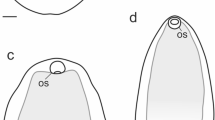Abstract
The behaviour of pediveligers of Ostrea edulis L. during attachment can be divided into 5 clearly defined phases. These behavioural phases are generally successive, and may be a hierarchy of fixed motor patterns which terminates in the consummatory act of cementing. During attachment, the larva utilises two different mechanisms of movement: the first, a fast, smooth, gliding action is probably due to cilia only; the second, a jerky, muscular method which becomes progressively slower as cementing is approached, is related to the burrowing movements of adult lamellibranchs. The byssus thread, which is discharged during the period of muscular locomotion, was the only secretion seen, but the site of its discharge could not be determined by direct observation.
Similar content being viewed by others
Literature Cited
Ansell, A. D.: Observations on burrowing in the Veneridae (Eulamellibranchia). Biol. Bull. mar. biol. Lab., Woods Hole 123, 521–530 (1962).
Bayne, B. L.: Responses of Mytilus edulis larvae to increases in hydrostatic pressure. Nature, Lond. 198, 406–407 (1963).
—: The gregarious behaviour of the larvae of Ostrea edulis L. at settlement. J. mar. biol. Ass. U.K. 49, 327–356 (1969).
Bullock, T. H. and G. A. Horridge: Structure and function in the nervous systems of invertebrates, 1719 pp. San Francisco and London: Freeman 1965.
Carriker, M. R.: Interrelation of functional morphology, behaviour, and autocology in early stages of the bivalve Mercenaria mercenaria. J. Elisha Mitchell scient. Soc. 77, 168–241 (1961).
Clausen, C.: On the anatomy and histology of the eulamellibranch Kelliella miliaris (Philippi) with observations on the ciliary mechanisms in the mantle cavity. Nytt Mag. Zool. 6, 144–174 (1958).
Cole, H. A.: The fate of the larval organs in the metamorphosis of Ostrea edulis. J. mar. biol. Ass. U.K. 22, 469–484 (1938).
— and E. W. Knight-Jones: Some observations and experiments on the setting behaviour of larvae of Ostrea edulis. J. Cons. perm. int. Explor. Mer 14, 86–105 (1939).
Cranfield, H. J.: A study of the morphology, ultrastructure, and histochemistry of the foot of the pediveliger of Ostrea edulis. Mar. Biol. 22, 187–202 (1973).
Crisp, D. J. and P. S. Meadows: Adsorbed layers—the stimulus to settlement in barnacles. Proc. R. Soc. (Ser. B) 158, 364–387 (1963).
Eibl-Eibesfeldt, I.: Ethology: the biology of behaviour, 530 pp. New York: Holt Rinehart & Winston 1970.
Erdmann, W.: Untersuchungen über die Lebensgeschichte der Auster. Nr 5. Über die Entwicklung und die Anatomie der „ansatzreifen” Larve von Ostrea edulis mit Bemerkungen über die Lebensgeschichte der Auster. Wiss. Meeresunters. (Abt. Helgoland) 19, 1–25 (1934).
Hickman, R. W. and Ll. D. Gruffydd: The histology of the larva of Ostrea edulis during metamorphosis. In: Fourth European marine biology symposium, pp 281–294. Ed. by D. J. Crisp. Cambridge: Cambridge University Press 1971.
Isham, L. B. and J. Q. Tierney: Some aspects of the larval development and metamorphosis of Teredo (Lyrodus) pedicellata de Quatrefages. Bull. mar. Sci. Gulf Caribb. 2, 574–589 (1953).
Knight-Jones, E. W.: Gregariousness and some other aspects of the setting behaviour of Spirorbis. J. mar. biol. Ass. U.K. 30, 201–222 (1951).
—: Decreased discrimination during setting after prolonged planktonic life in larvae of Spirorbis borealis (Serpulidae). J. mar. biol. Ass. U.K. 32, 337–345 (1953).
— and D. J. Crisp: Gregariousness in barnacles in relation to the fouling of ships and to anti-fouling research. Nature, Lond. 171, 1109–1110 (1953).
Loosanoff, V. L., H. C. Davis and P. E. Chanley: Dimensions and shapes of larvae of some marine bivalve mollusks. Malacologia 4, 351–435 (1966).
Nelson, T. C.: The attachment of oyster larvae. Biol. Bull. mar. biol. Lab., Woods Hole 46, 141–151 (1924).
Ponder, W. F.: The biology of the genus Arthritica. Trans. R. Soc. N.Z. (Zoology) 6, 75–86 (1965).
Popham, M. L.: The mantle cavity of some of the Erycinidae, Montacutidae, and Galeommatidae with special reference to the ciliary mechanisms. J. mar. biol. Ass. U.K. 24, 549–587 (1940).
Prytherch, H. F.: The role of copper in the setting, metamorphosis, and distribution of the American oyster, Ostrea virginica. Ecol. Monogr. 4, 45–107 (1934).
Quayle, D. B.: Movements in Venerupis (=Paphia) pullastra (Montagu). Proc. malac. Soc. Lond. 28, 31–37 (1949).
—: Structure and biology of the larva and spat of Venerupis pullastra (Montagu). Trans. R. Soc. Edinb. 62, 255–297 (1952).
Reese, E. S.: Ethology and marine biology. A. Rev. Oceanogr. mar. Biol. 2, 455–488 (1964).
Roughly, T. C.: The life history of the Australian oyster (Ostrea commercialis). Proc. Linn. Soc. N.S.W. 58, 279–332 (1933).
Tinbergen, N.: The study of instinct, 288 pp. Oxford: Oxford University Press 1951.
Walne, P. R.: Experiments in the large-scale culture of the larvae of Ostrea edulis L. Fishery Invest., Lond. (Ser. 2) 25 (4), 1–53 (1966).
Williams, G. B.: Substrate specificity as a factor in the biology of certain sedentary marine invertebrates. Ph.D. thesis, 158 pp. University College of North Wales 1965.
Wisely, B.: Observations on the settling behaviour of larvae of the tubeworm Spirorbis borealis Daudin (Polychaeta). Aust. J. mar. Freshwat. Res. 11, 55–72 (1960).
Author information
Authors and Affiliations
Additional information
Communicated by G. F. Humphrey, Sydney
Rights and permissions
About this article
Cite this article
Cranfield, H.J. Observations on the behaviour of the pediveliger of Ostrea edulis during attachment and cementing. Mar. Biol. 22, 203–209 (1973). https://doi.org/10.1007/BF00389174
Accepted:
Issue Date:
DOI: https://doi.org/10.1007/BF00389174




